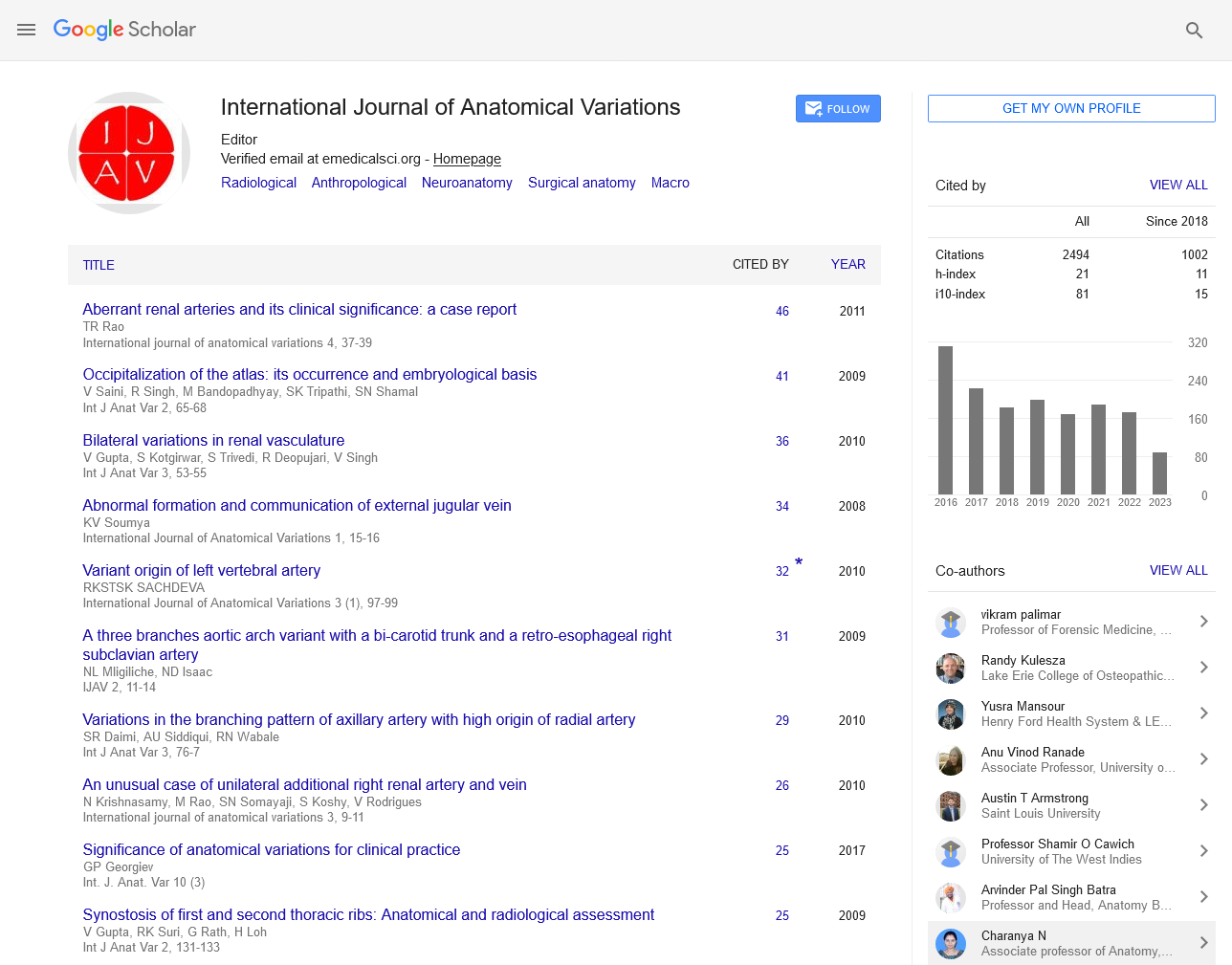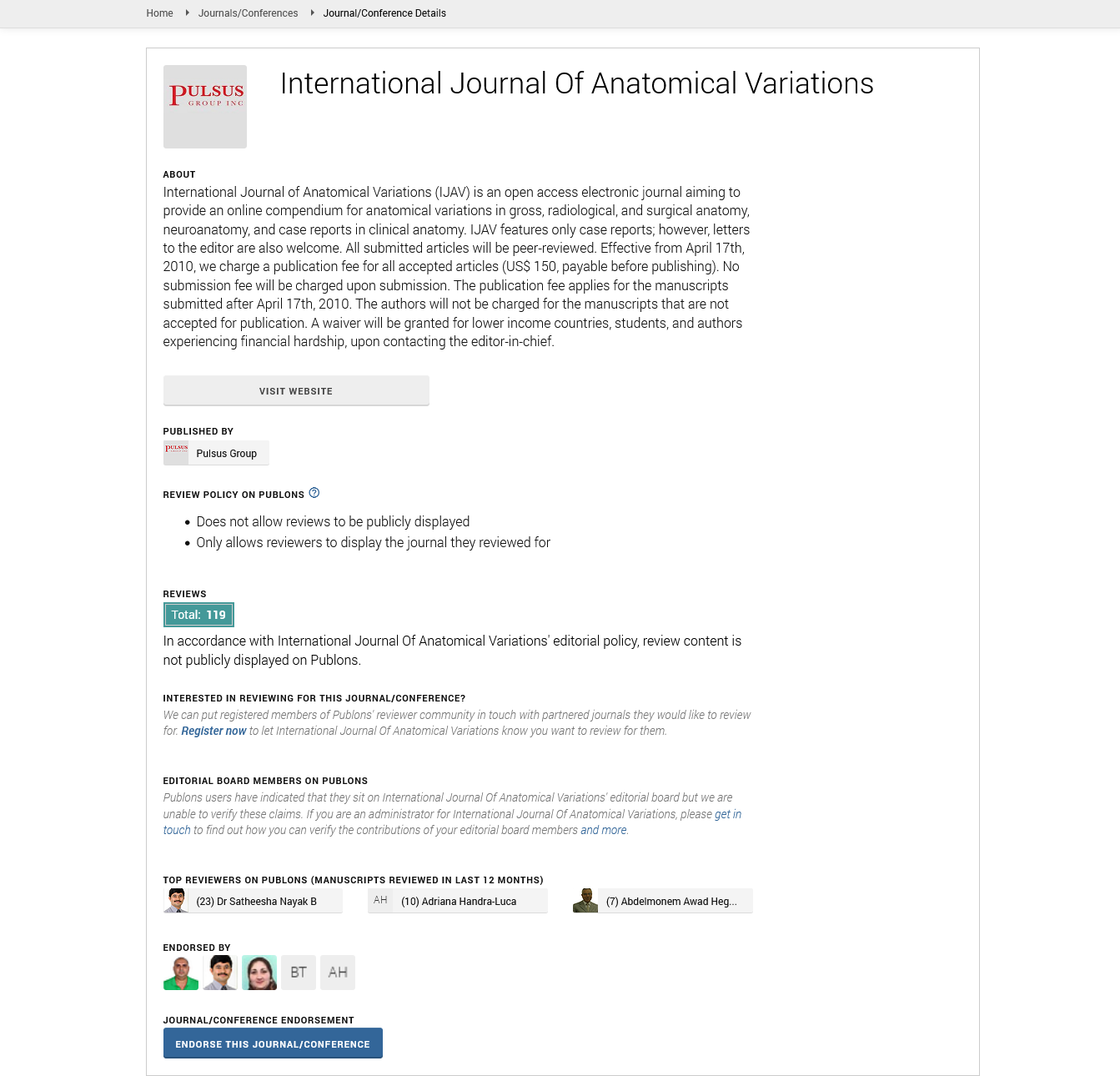Surgical Anatomy Variations Implications for Clinical Practice and Surgical Planning
Received: 01-Feb-2025, Manuscript No. ijav-25-7620; Editor assigned: 04-Feb-2025, Pre QC No. ijav-25-7620 (PQ); Reviewed: 19-Feb-2025 QC No. ijav-25-7620; Revised: 26-Apr-2025, Manuscript No. ijav-25-7620 (R); Published: 28-Feb-2025, DOI: 10.37532/1308-4038.18(2).484
Citation: Singh S. Surgical Anatomy Variations Implications for Clinical Practice and Surgical Planning. Int J Anat Var. 2025;18(2): 735-736.
This open-access article is distributed under the terms of the Creative Commons Attribution Non-Commercial License (CC BY-NC) (http://creativecommons.org/licenses/by-nc/4.0/), which permits reuse, distribution and reproduction of the article, provided that the original work is properly cited and the reuse is restricted to noncommercial purposes. For commercial reuse, contact reprints@pulsus.com
Abstract
Anatomical variations are a fundamental aspect of human biology, often overlooked in traditional anatomical education. These deviations from the “standard” anatomical structure, while typically benign, can pose significant challenges in surgical practice. This paper provides a comprehensive review of the most clinically significant anatomical variations encountered across major surgical disciplines. It emphasizes the necessity for preoperative recognition, discusses their embryological basis, and evaluates modern imaging techniques and intraoperative strategies that help mitigate surgical risk. Increased awareness and understanding of these variations are crucial for improving surgical outcomes, reducing iatrogenic injuries, and personalizing patient care.
INTRODUCTION
Human anatomy has long been considered the cornerstone of medical education. However, the variability in anatomical structures among individuals is an important reality that significantly impacts clinical outcomes, particularly in surgery. “Surgical anatomy variations” refer to the differences in size, shape, location [1], and number of anatomical structures such as blood vessels, nerves, and organs. These variations can be congenital or acquired and may remain asymptomatic throughout life, only becoming clinically relevant in operative settings. Failure to recognize and accommodate anatomical variations can lead to inadvertent damage to vital structures, poor surgical outcomes, or even fatal complications. Hence, the integration of anatomical variability into surgical education, diagnostic imaging, and operative planning is of paramount importance. Anatomical variations are a universal characteristic of the human body, reflecting the complexity and individuality of each person's physiological structure. While anatomical textbooks traditionally describe the "standard" human anatomy, clinical practice reveals that such variations are far more common than previously acknowledged. Surgical anatomy variations, which refer to deviations in the typical structure and arrangement of organs, vessels, nerves, and other anatomical entities, play a crucial role in shaping surgical outcomes. These variations can be congenital, resulting from developmental anomalies, or acquired, due to disease, trauma, or surgical interventions. For surgeons, the implications of these variations are profound. An understanding of surgical anatomy variations is not only fundamental for reducing the risk of iatrogenic injury but is also essential for developing more personalized and effective surgical strategies [2]. Whether during routine procedures or complex interventions, the ability to anticipate and adapt to these variations can be the difference between a successful surgery and a life-threatening complication. Historically, the study of anatomy focused primarily on a "one-size-fits-all" model, often ignoring the natural diversity of human anatomy. However, as the field of surgery advances, particularly with the advent of minimally invasive techniques, robotic surgery, and personalized medicine, the recognition and management of anatomical variations have become increasingly critical. The role of preoperative imaging, advanced diagnostic tools, and intraoperative navigation systems has further emphasized the need for surgeons to be adept in identifying and responding to these variations in real-time. This paper aims to provide an overview of the clinical significance of surgical anatomy variations, with a focus on how these differences impact surgical planning, techniques, and patient safety. By exploring common anatomical deviations across various organ systems and highlighting the importance of preoperative preparation, the article will underscore the necessity of integrating knowledge of anatomical variations into daily surgical practice for improved outcomes and patient care [3].
EMBRYOLOGICAL BASIS OF ANATOMICAL VARIATIONS
Many anatomical variations originate during embryological development. The failure of certain embryonic structures to regress or improper fusion of developing tissues can lead to persistent vascular remnants, accessory organs, or atypical nerve courses. Persistent left superior vena cava results from the failure of the left anterior cardinal vein to regress. Aberrant right subclavian artery arises due to the involution of the right fourth aortic arch. Accessory spleens result from incomplete fusion of splenic tissue during development [4].
COMMON SURGICAL ANATOMY VARIATIONS BY SYSTEM
Anomalous origin of the left coronary artery from the pulmonary artery (ALCAPA) or a single coronary artery can significantly influence cardiac surgery and interventional cardiology. May complicate retroperitoneal surgeries or placement of IVC filters [5].
GASTROINTESTINAL SYSTEM
Present in up to 15% of the population, arising from the superior mesenteric artery; critical during hepatobiliary surgery. A persistent vitelline duct remnant, often asymptomatic but can mimic appendicitis or cause GI bleeding.
CONCLUSION
Anatomical variations are not merely academic curiosities—they are clinically significant realities that must be acknowledged and understood in the surgical arena. Surgeons must develop a vigilant approach toward recognizing these differences through improved education, diagnostic imaging, and surgical experience. As personalized medicine evolves, tailoring surgical approaches to individual anatomical profiles will become a standard of care, improving both safety and efficacy.
REFERENCES
- Alok A YA (2020) Membranous Nephropathy
- Fogo AB, Lusco MA, Najafian B, Alpers CE (2015) Atlas of Renal Pathology: Membranous Nephropathy. Am J Kidney Dis 66: 15-17.
- Fresquet M, Rhoden SJ, Jowitt TA, McKenzie EA, Roberts I et al. (2020) Auto antigens PLA2R and THSD7A in membranous nephropathy share a common epitope motif in the N-terminal domain. J Auto immun 106: 102308.
- E Von Mutius (2010) 99th Dahlem conference on infection, inflammation and chronic inflammatory disorders: viruses, autoimmunity and immune regulation. Clin Exp Immunol 160: 113-119.
- Blyth CC, Robertson PW (2006) Anti-streptococcal antibodies in the diagnosis of acute and post-streptococcal disease: streptokinase versus streptolysin O and deoxyribonucleic B.Pathology 38: 152-162.
Indexed at, Google Scholar, Crossref
Indexed at, Google Scholar, Crossref






